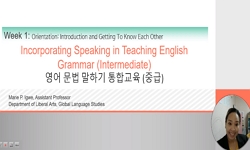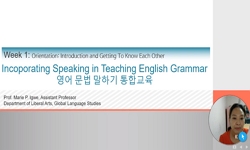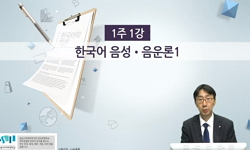The purpose of this study is to examine the current status and limitations of the integrated Korean language education which are being used in the field for the purpose of meeting the goal of ‘enhancing the abilities to use Korean language,’ which...
http://chineseinput.net/에서 pinyin(병음)방식으로 중국어를 변환할 수 있습니다.
변환된 중국어를 복사하여 사용하시면 됩니다.
- 中文 을 입력하시려면 zhongwen을 입력하시고 space를누르시면됩니다.
- 北京 을 입력하시려면 beijing을 입력하시고 space를 누르시면 됩니다.
높임 표현의 통합적 국어 교육 방안 연구 –듣기·말하기와의 영역 간 통합을 중심으로 = A Study on the Integrated Korean Language Education Research Strategy for Honorifics - Focusing on the Integration between the Domains of Listening and Speaking -
한글로보기https://www.riss.kr/link?id=T16909446
- 저자
-
발행사항
서울 : 연세대학교 교육대학원, 2024
-
학위논문사항
학위논문(석사) -- 연세대학교 교육대학원 , 국어교육전공 , 2024. 2
-
발행연도
2024
-
작성언어
한국어
-
주제어
국어교육 ; 문법교육 ; 통합교육 ; 통합교육의 개념 ; 통합 교육의 한계 ; 통합적 문법 교육 ; 높임표현 ; 높임표현의 담화적 특성 ; 영역 간 통합 ; Korean language education ; grammar education ; integrated education ; concept of integrated education ; limitations of integrated education ; integrated grammar education ; honorific expressions ; conversational characteristics of honorifics ; integration between domains
-
DDC
411
-
발행국(도시)
서울
-
형태사항
vi, 85장 ; 26 cm
-
일반주기명
지도교수: 유현경
-
UCI식별코드
I804:11046-000000553248
- 소장기관
-
0
상세조회 -
0
다운로드
부가정보
다국어 초록 (Multilingual Abstract)
the integrated Korean language education which are being used in the field for
the purpose of meeting the goal of ‘enhancing the abilities to use Korean
language,’ which is also the ultimate goal of Korean language education, while
focusing on the exploration of the possibilities for the integration between
the expression of honorifics in the domain of grammar and the domains of
listening and speaking.
To meet the goals of Korean language education, it is necessary to design
classes while taking the applications in real life scenarios into account,
rather than the previous learning/teaching methods focused on the transfer of
knowledge. Especially, grammar education in Korean language education is found
to be limited to mere test of knowledge and memory for the sake of evaluation.
It would be more desirable to help the student realize that the knowledge in
Korean language that they learn at school is not only for the sake of tests but
to help them in real life.
The integrated education which has been introduced under this context is to
focus on ‘the transfer and application of knowledge’ by learners, who are
assisted to obtain the abilities to solve real-life problems utilizing the
knowledge that they learned from their schools. In this study, the researcher
focused on the strategies that could be applied to the grammar education for
Korean language. First, the researcher examined the theoretical background of
- 85 -
Korean grammar education and set the honorifics as one of the examples.
Honorific expressions are a grammatical element that can be used in
conversational situations. Therefore, in this study, the researcher examined
the possibility of integrating it with the domains of listening and speaking.
By analyzing the revised 2015 curriculum and text books, the researcher learned
that, while honorifics are frequently used by Korean speakers, they were not
established as a separated content element. Instead, it was classified as one
of grammatical elements, which limited the opportunities for learners to
utilize their knowledge. For this, the researcher concluded that it could be
integrated along with language manners among the content elements for listening
and speaking to form class sessions. Further, the researcher also examined the
possibility of realizing integrated Korean language classes utilizing honorific
expressions in listening and speaking situations.
With this, the researcher examined the reality and limitations in classrooms
to provide recommendations for the successful integrated Korean language
education strategies for the honorifics in Korean language through surveys and
in-depth interviews and made suggestions on the strategies for integrated
grammar educations for honorifics in two different perspectives.
Therefore, the implications of this study is that it highlighted the fact that
honorifics, which reflected the nature of Korean language, have been neglected
and, instead of blindly criticizing that they were not successfully implemented
in Korean language education, the researcher conducted an in-depth
investigation of the awareness and experience of teachers about integrated
education and honorifics, providing realistic directions for integrated Korean
language education for honorifics.
The purpose of this study is to examine the current status and limitations of
the integrated Korean language education which are being used in the field for
the purpose of meeting the goal of ‘enhancing the abilities to use Korean
language,’ which is also the ultimate goal of Korean language education, while
focusing on the exploration of the possibilities for the integration between
the expression of honorifics in the domain of grammar and the domains of
listening and speaking.
To meet the goals of Korean language education, it is necessary to design
classes while taking the applications in real life scenarios into account,
rather than the previous learning/teaching methods focused on the transfer of
knowledge. Especially, grammar education in Korean language education is found
to be limited to mere test of knowledge and memory for the sake of evaluation.
It would be more desirable to help the student realize that the knowledge in
Korean language that they learn at school is not only for the sake of tests but
to help them in real life.
The integrated education which has been introduced under this context is to
focus on ‘the transfer and application of knowledge’ by learners, who are
assisted to obtain the abilities to solve real-life problems utilizing the
knowledge that they learned from their schools. In this study, the researcher
focused on the strategies that could be applied to the grammar education for
Korean language. First, the researcher examined the theoretical background of
- 85 -
Korean grammar education and set the honorifics as one of the examples.
Honorific expressions are a grammatical element that can be used in
conversational situations. Therefore, in this study, the researcher examined
the possibility of integrating it with the domains of listening and speaking.
By analyzing the revised 2015 curriculum and text books, the researcher learned
that, while honorifics are frequently used by Korean speakers, they were not
established as a separated content element. Instead, it was classified as one
of grammatical elements, which limited the opportunities for learners to
utilize their knowledge. For this, the researcher concluded that it could be
integrated along with language manners among the content elements for listening
and speaking to form class sessions. Further, the researcher also examined the
possibility of realizing integrated Korean language classes utilizing honorific
expressions in listening and speaking situations.
With this, the researcher examined the reality and limitations in classrooms
to provide recommendations for the successful integrated Korean language
education strategies for the honorifics in Korean language through surveys and
in-depth interviews and made suggestions on the strategies for integrated
grammar educations for honorifics in two different perspectives.
Therefore, the implications of this study is that it highlighted the fact that
honorifics, which reflected the nature of Korean language, have been neglected
and, instead of blindly criticizing that they were not successfully implemented
in Korean language education, the researcher conducted an in-depth
investigation of the awareness and experience of teachers about integrated
education and honorifics, providing realistic directions for integrated Korean
language education for honorifics.
국문 초록 (Abstract)
국어 교육의 목표를 달성하기 위해서는 기존의 지식 습득 위주의 교수·학습 방식에서 벗어나 실생활에의 적용을 염두에 두고 수업을 구성할 필요가 있다. 특히, 국어교육에서의 문법 교육은 평가를 위한 단순 암기의 지식 교육에 머물러 있는 경우가 많다. 학교에서 배운 국어 지식이 더 이상 평가의 용도로서만 활용되는 것이 아닌 실제 사용할 때 도움이 되는 지식임을 경험하도록 도움을 주어야 할 것이다.
이러한 맥락에서 등장한 통합 교육은 학습자의 ‘지식의 전이 및 활용’을 초점으로 하고 학습자가 배운 지식을 적용하여 실생활의 문제를 해결하는 능력을 갖도록 도움을 주는 교육 방식이다. 본 연구에서는 이를 국어 문법 교육에 적용할 수 있는 방안을 연구한다. 먼저 통합 교육이 무엇인지 이론적 배경을 살펴보고, 그것의 한 예로 문법 영역인 높임 표현을 설정하였다. 높임 표현은 담화적 상황에서 실현되는 경향이 강한 문법 요소이다. 따라서 본 연구에서는 이를 듣기·말하기 영역과 통합 할 수 있는 가능성에 대해 살펴보았다.
2015개정 교육과정 및 교과서 분석을 통하여 높임 표현이 국어 사용의 상황에서 빈번하게 사용됨에도 불구하고 단독 내용 요소로 설정된 것이 아니라, 문법 요소의 하나로서 설정되어 학습자가 배운 지식을 활용할 수 있는 기회가 적다는 것을 포착하였다. 이를 위해 듣기·말하기 영역의 내용 요소에서 언어 예절과 통합하여 수업을 구성할 수 있다고 보았고, 더 나아가 듣기·말하기의 상황에서 높임표현을 활용하여 통합적 국어 수업을 실현할 수 있는 가능성 또한 살펴보았다.
이를 바탕으로 성공적인 높임 표현의 통합적 국어 교육 방안을 제언하기 위하여 교육현장의 현실적인 여건과 한계를 설문조사와 심층 면담을 통해 알아보고 높임표현의 통합적 문법 교육을 할 수 있는 방안을 두 가지 관점에서 제언하였다.
따라서 본 연구는 한국어의 특질을 반영하는 높임 표현이 교육적으로 등한시 되었다는 점을 역설하고 현장에서 이를 제대로 실현하지 못한다는 점을 무조건적으로 비판하기보다는 통합 교육 및 높임 표현에 대한 교사의 인식과 경험을 구체적으로 조사함으로써 현실적으로 높임 표현의 통합적 국어 교육이 가능한 방향성을 제언했다는 점에서 의의가 있다.
본 연구는 국어 교육의 궁극적인 목표인 '국어 사용 능력 신장'이라는 목표를 달성하기 위해 현장에서 다뤄지고 있는 통합적 국어 교육의 실태와 한계를 파악하고 그중에서도 문법 영역의 ...
본 연구는 국어 교육의 궁극적인 목표인 '국어 사용 능력 신장'이라는 목표를 달성하기 위해 현장에서 다뤄지고 있는 통합적 국어 교육의 실태와 한계를 파악하고 그중에서도 문법 영역의 높임 표현과 듣기·말하기의 통합 가능성 탐색에 중점을 둔 연구이다.
국어 교육의 목표를 달성하기 위해서는 기존의 지식 습득 위주의 교수·학습 방식에서 벗어나 실생활에의 적용을 염두에 두고 수업을 구성할 필요가 있다. 특히, 국어교육에서의 문법 교육은 평가를 위한 단순 암기의 지식 교육에 머물러 있는 경우가 많다. 학교에서 배운 국어 지식이 더 이상 평가의 용도로서만 활용되는 것이 아닌 실제 사용할 때 도움이 되는 지식임을 경험하도록 도움을 주어야 할 것이다.
이러한 맥락에서 등장한 통합 교육은 학습자의 ‘지식의 전이 및 활용’을 초점으로 하고 학습자가 배운 지식을 적용하여 실생활의 문제를 해결하는 능력을 갖도록 도움을 주는 교육 방식이다. 본 연구에서는 이를 국어 문법 교육에 적용할 수 있는 방안을 연구한다. 먼저 통합 교육이 무엇인지 이론적 배경을 살펴보고, 그것의 한 예로 문법 영역인 높임 표현을 설정하였다. 높임 표현은 담화적 상황에서 실현되는 경향이 강한 문법 요소이다. 따라서 본 연구에서는 이를 듣기·말하기 영역과 통합 할 수 있는 가능성에 대해 살펴보았다.
2015개정 교육과정 및 교과서 분석을 통하여 높임 표현이 국어 사용의 상황에서 빈번하게 사용됨에도 불구하고 단독 내용 요소로 설정된 것이 아니라, 문법 요소의 하나로서 설정되어 학습자가 배운 지식을 활용할 수 있는 기회가 적다는 것을 포착하였다. 이를 위해 듣기·말하기 영역의 내용 요소에서 언어 예절과 통합하여 수업을 구성할 수 있다고 보았고, 더 나아가 듣기·말하기의 상황에서 높임표현을 활용하여 통합적 국어 수업을 실현할 수 있는 가능성 또한 살펴보았다.
이를 바탕으로 성공적인 높임 표현의 통합적 국어 교육 방안을 제언하기 위하여 교육현장의 현실적인 여건과 한계를 설문조사와 심층 면담을 통해 알아보고 높임표현의 통합적 문법 교육을 할 수 있는 방안을 두 가지 관점에서 제언하였다.
따라서 본 연구는 한국어의 특질을 반영하는 높임 표현이 교육적으로 등한시 되었다는 점을 역설하고 현장에서 이를 제대로 실현하지 못한다는 점을 무조건적으로 비판하기보다는 통합 교육 및 높임 표현에 대한 교사의 인식과 경험을 구체적으로 조사함으로써 현실적으로 높임 표현의 통합적 국어 교육이 가능한 방향성을 제언했다는 점에서 의의가 있다.
목차 (Table of Contents)
- 1.서론
- 1.1. 연구의 목적 및 필요성
- 1.2. 연구 대상 및 방법
- 1.3. 선행 연구 검토
- 1.서론
- 1.1. 연구의 목적 및 필요성
- 1.2. 연구 대상 및 방법
- 1.3. 선행 연구 검토
- 2. 기본적 논의
- 2.1. 통합적 문법 교육의 개념
- 2.2. 통합적 문법 교육의 원리
- 2.3. 통합적 문법 교육의 효용성
- 3. 2015개정 교육과정 및 교과서 분석
- 3.1. 2015 개정 국어과 교육과정 분석
- 3.1.1. 고등학교 1학년 <국어> 교육과정 분석
- 3.1.2. <화법과 작문> 교육과정 분석
- 3.1.3. <언어와 매체> 교육과정 분석
- 3.1.4. 교육과정 분석 결과
- 3.2. 2015개정 교과서 분석
- 3.2.1. <국어> 교과서 11종 분석
- 3.2.2. 교과서 분석 결과
- 4. 설문 조사 및 심층 인터뷰 결과 분석
- 4.1. 국어과 통합적 문법 교육에 대한 국어 교사의 인식과 경험
- 4.2. 높임표현 교육관련 국어 교사의 인식과 경험
- 4.3. 높임 표현의 통합적 국어교육을 위한 제언
- 5. 결론
- 참고문헌
- [부록]
- Abstract












